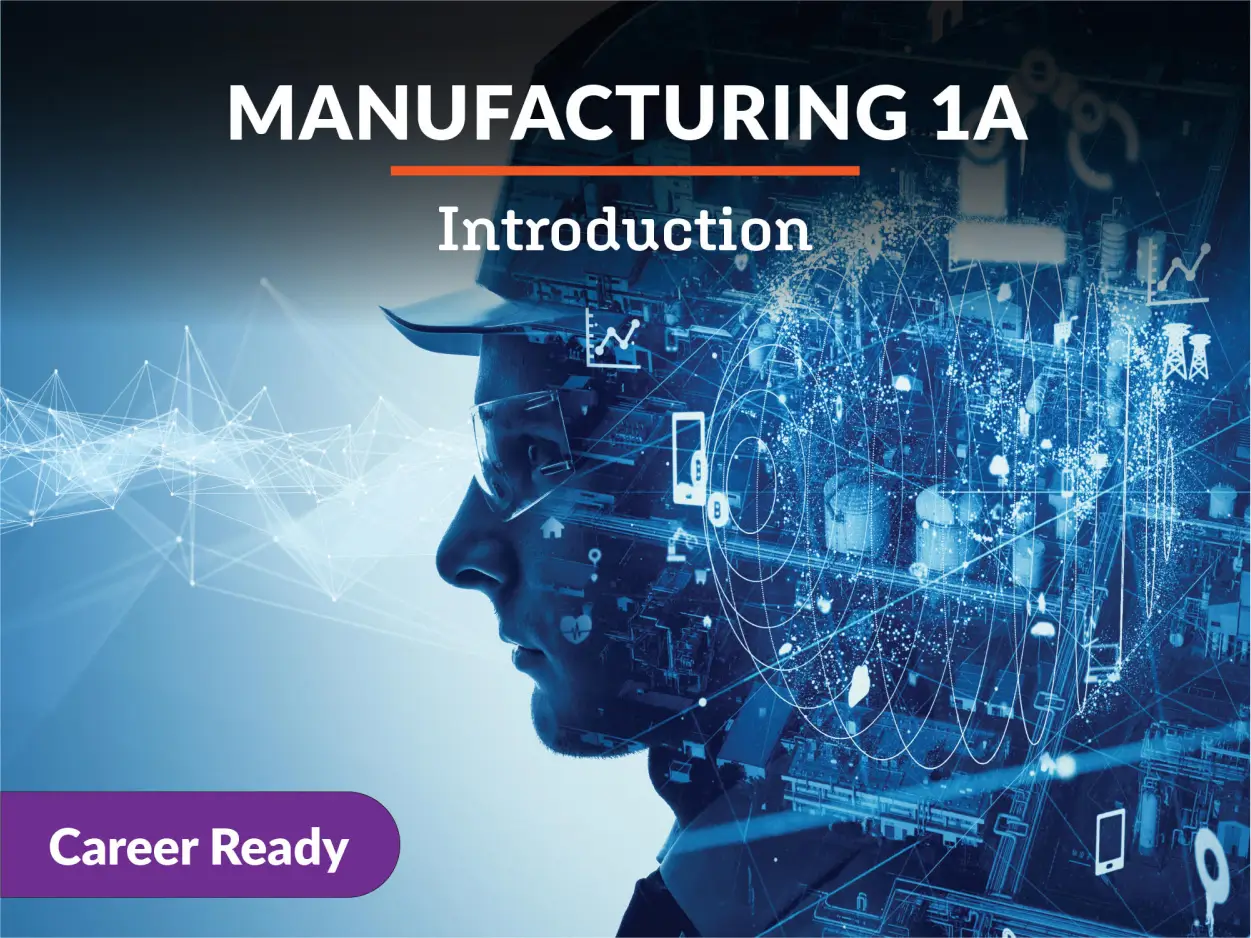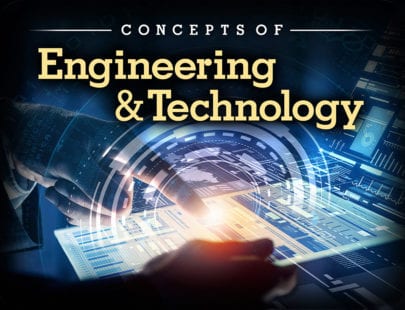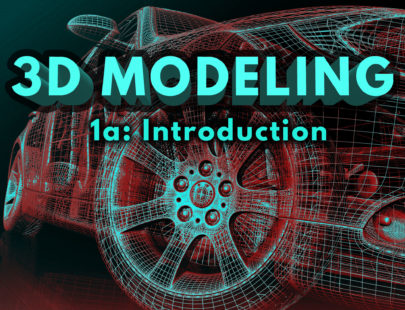
Manufacturing 1a: Introduction
Do you ever look at your man-made surroundings and find yourself fascinated at how it was created? Modern manufacturing is the answer. In this course, you will learn the big picture of manufacturing- categories, how companies decide what to produce, and how companies produce it- and making items in the most cost-effective way. You will also study the history of manufacturing technologies, so you can see the future possibilities for manufacturing more clearly as you start to do activities where you’ll learn how your ideas can become a reality. Get ready to unveil how modern manufacturing creates the world we live in. Let’s get started!
Units at a Glance
Unit 1: Fields of Manufacturing
Our quality of life is greatly enhanced by technology and the consumer items that are available to us. Can you imagine a day without a smartphone or another mobile device? What about the latest in sunglasses with integrated high-definition audio? Have you ever wondered how these products are made or how many different career paths are intertwined to bring them to the shelves of local stores? What about how our daily purchases and consumption as consumers have far-reaching impacts? Welcome to the world of manufacturing.
What will you learn in this unit?
- Define manufacturing and describe the manufacturing process
- Compare and contrast manufacturing capability and capacity
- Discuss the role of manufacturing in a sustainable economy
- Explain the different manufacturing sectors based on products
- Identify the government agency that is responsible for overseeing product quality for items used or consumed by people
Unit 2: The Science of Materials
Have you ever wondered why a crystal ball shatters when dropped, but a rubber ball bounces? Materials of all sorts are used for a vast array of applications, but the choice of material is by design! So how does one choose the right material? In manufacturing, details about the product, including what it is and how it needs to function, lead designers and engineers to select the appropriate material. It’s not a Magic 8 Ball that magically gives us the answers—instead, knowledge about materials and how they behave regarding applied forces, heat, electrical current, ultraviolet light, and many other factors will lead to the correct material for the job.
What will you learn in this unit?
- Identify the building blocks of material
- Define thermal and electrical properties of materials
- Differentiate between physical and chemical material properties
- Explain the difference between ferrous and non-ferrous metals
- Describe polymers and their subcategories
Unit 3: Basic Manufacturing Processes
How do we get from raw materials to a shiny new product in great packaging? We follow the steps of the manufacturing process! There are a number of processing and assembly methods to make sure products are formed the way they need to be, and finishing methods ensure a robust, reliable product. Because manufacturing is a business, the process is documented each step of the way through inventory and various orders and invoices. We might be used to clicking “buy now” and waiting for that package to show up on our doorstep, but in this unit, you will get to see the hundreds of smaller steps that go into creating that product, packaging it, and getting it to your door.
What will you learn in this unit?
- Identify the five distinct stages to the manufacturing workflow
- Differentiate between the forms of casting processes
- Determine if an assembly process is permanent or reversible
- Describe the two modes of production
Unit 4: Evolution of Manufacturing Technologies
Over the past 120 years, cars have become a commodity, the human genome has been fully decoded, and smartphones can beat the first supercomputers in a processing competition. Machines can learn—artificial intelligence is getting smarter by the minute—and things that once sounded like science fiction have become real products and processes. Let’s take a journey through the history of manufacturing to better appreciate where we stand today and acknowledge the contributions that got us here.
What will you learn in this unit?
- Trace the timeline of manufacturing from the beginning of the industrial revolution to current day
- Identify three persons in history that made significant contributions to manufacturing
- Describe current trends in advanced manufacturing
- Explain how computers have impacted manufacturing
Unit 5: Tools of the Trade
Every discipline and career path has a skill set and a proverbial “toolbox” necessary to be successful. In manufacturing, the tools used to transform materials and produce more valuable items are an essential extension of the individuals working on any step in the manufacturing process. Understanding tools and the general use for each tool reduces the time to complete tasks. It also minimizes the potential for damage to valuable items and injury to workers. This unit focuses on hand tools that are commonly encountered and used in a manufacturing setting as well as their proper storage and maintenance.
What will you learn in this unit?
- Secure materials you’re working on until the task is finished
- Fasten materials together with nuts and screws
- Adapt materials with hammering, chipping, cutting, and heat
- Store items, fluids, and gases of various sizes and uses
- Maintain and replace items following safety guideline and business needs
Unit 6: Bringing the Power
Nothing empowers manufacturing personnel quite like power tools. They’re awesome and provide many advantages over their hand-driven counterparts. In some cases, power tools are the only practical way to get a job done. Speed, improved force transfer, and decreased worker fatigue are just some examples of advantages. Still, there are drawbacks to be considered—for example, the tools cost more and with power comes increased risk. Safety always has to come first, but with proper care and training, personnel can have the peace of mind to plug in or charge up and get going.
What will you learn in this unit?
- Explain the uses of manual power tools
- Employ computers to control power tools
- Describe the range of machines used in larger manufacturing operations
- Work with future data-driven technology
Unit 7: Advanced Manufacturing
Modern manufacturing technologies are evolving to place the latest equipment and methods in the hands of as many as possible. Today, there are more users of high technology equipment then ever before. Advanced manufacturing allows humans to control machines with incredible power and precision. To do so, you’ll need to understand what the machines are capable of, what components and materials are used, and how you give the machines their marching orders. Integrated with the machine tools are the robotic tenders that sustain production in the absence of human hands. In this unit, you’ll explore all these concepts as well as new fields of manufacturing that are emerging. Get ready for everything from big robots that move tons to micro-scale assembly systems that are out of sight.
What will you learn in this unit?
- Detail the characteristics of advanced and digital manufacturing
- Suggest uses of additive manufacturing
- Identify the components of a robotic system
- Explain the materials used in and uses of micro-electro-mechanical systems
Unit 8: Staying Safe
In a fraction of a second, things can happen that will have a lifelong impact. That is, they can happen if safety is not a priority for everyone at a worksite. Workers constantly need to be on the lookout for safety hazards, from electrical dangers to wet floors. Equipment must be maintained and routine checks must be performed to make sure everything is as it should be. While self-awareness is essential, real safety comes when measures are put in place that prevent problems from occurring in the first place. This means having a safety plan in place and keeping up with guidelines from a variety of sources. A good mindset to have is this: If it looks unsafe, it is unsafe!
What will you learn in this unit?
- Create a safety plan for a workplace
- Describe general hazards of most workplaces
- Prepare to handle common emergencies
- Ensure maintenance tasks can be performed safely
Required Materials
Physical
- Household object (penny, battery, etc.)
- Ruler
- Scale
Software
- Graphic design software
- Presentation software
- Word processing software
Optional
- Art supplies
- Audio recording device
- Digital camera
- Spreadsheet software
- Video recording device



